Influence of Trans-Boundary Air Pollution on the Urban Atmosphere in Fukuoka, Japan
Abstract
:1. Introduction
2. Experiments
2.1. Locations and Periods
2.2. Instruments
2.3. Analysis
3. Results
3.1. Chemical Composition
3.2. PMF Analysis
3.3. Simulation Results
4. Discussion
4.1. Air Quality in Fukuoka City-Local vs. Trans-Boundary Air Pollution
4.2. High PM2.5 Event in Summer
5. Conclusions
Acknowledgments
Author Contributions
Conflicts of Interest
Abbreviations
| PM | Particulate matter |
| Q-AMS | Quadrupole-type aerosol mass spectrometer |
| Q-ACSM | Quadrupole-type aerosol chemical speciation monitor |
| TEOM | Tapered element oscillating microbalance |
| PMF | Positive matrix factorization |
| CFORS | Chemical weather forecasting system |
| OA | Organic aerosol |
| LV-OOA | Low-volatile oxygenated OA |
| SV-OOA | Semi- volatile oxygenated OA |
| HOA | Hydrocarbon-like OA |
References
- Kurokawa, J.; Ohara, T.; Morikawa, T.; Hanayama, S.; Janssens-Maenhout, G.; Fukui, T.; Kawashima, K.; Akimoto, H. Emissions of air pollutants and greenhouse gases over Asian regions during 2000–2008: Regional Emission Inventory in ASia (REAS) Version 2. Atmos. Chem. Phys. 2013, 13, 11019–11058. [Google Scholar] [CrossRef]
- Lu, Z.; Streets, D.G.; Zhang, Q.; Wang, S.; Carmichael, G.R.; Cheng, Y.F.; Wei, C.; Chin, M.; Diehl, T.; Tan, Q. Sulfur dioxide emissions in China and sulfur trends in East Asia since 2000. Atmos. Chem. Phys. 2010, 10, 6311–6331. [Google Scholar] [CrossRef]
- Takami, A.; Miyoshi, T.; Shimono, A.; Hatakeyama, S. Chemical composition of fine aerosol measured by AMS at Fukue Island, Japan during APEX Period. Atmos. Environ. 2005, 39, 4913–4924. [Google Scholar] [CrossRef]
- Takami, A.; Miyoshi, T.; Shimono, A.; Kaneyasu, N.; Kato, S.; Kajii, Y.; Hatakeyama, S. Transport of anthropogenic aerosols from Asia and subsequent chemical transformation. J. Geophys. Res. 2007, 112, D22S31. [Google Scholar] [CrossRef]
- Kanaya, Y.; Taketani, F.; Irie, H.; Komazaki, Y.; Takashima, H.; Uno, I. PM2.5 mass concentrations observed at Fukue island, Kyushu, Japan: Exceeding the atmospheric environmental standard. J. Jpn. Soc. Atmos. Environ. 2010, 45, 289–292. (In Japanese) [Google Scholar]
- Kaneyasu, N.; Takami, A.; Sato, K.; Hatakeyama, S.; Hayashi, M.; Hara, K.; Lim-Serok, C.; Joon-Young, A. Long-range transport of PM2.5 in northern Kyushu area in spring. J. Jpn. Soc. Atmos. Environ. 2010, 45, 227–234. (In Japanese) [Google Scholar]
- Kaneyasu, N.; Takami, A.; Sato, K.; Hatakeyama, S.; Hayashi, M.; Hara, T.; Kawamoto, K.; Yamamoto, S. Year-round behavior of PM2.5 in a remote island and urban sites in northern Kyushu area, Japan. J. Jpn. Soc. Atmos. Environ. 2011, 46, 111–118. (In Japanese) [Google Scholar]
- Takami, A.; Mayama, N.; Sakamoto, T.; Ohishi, K.; Irei, S.; Yoshino, A.; Hatakeyama, S.; Murano, K.; Sadanaga, Y.; Bandow, H.; et al. Structural analysis of aerosol particles by microscopic observation using a time-of-flight secondary ion mass spectrometer. J. Geophys. Res. 2013, 118, 6726–6737. [Google Scholar] [CrossRef]
- Takami, A.; Miyoshi, T.; Irei, S.; Yoshino, A.; Sato, K.; Shimizu, A.; Hayashi, M.; Hara, K.; Kaneyasu, N.; Hatakeyama, S. Analysis of organic aerosol in Fukuoka, Japan using a PMF method. Aerosol Air Qual. Res. 2016, 16, 314–322. [Google Scholar] [CrossRef]
- Murano, K.; Mukai, H.; Hatakeyama, S.; Jang, E.S.; Uno, I. Trans-boundary air pollution over remote islands in Japan: Observed data and estimates from a numerical model. Atmos. Environ. 2000, 34, 5139–5149. [Google Scholar] [CrossRef]
- Shimohara, T.; Oishi, O.; Utsunomiya, A.; Mukai, H.; Hatakeyama, S.; Jang, E.-S.; Uno, I.; Murano, K. Characterization of atmospheric air pollutants at two sites in northern Kyushu, Japan—Chemical form, and chemical reaction. Atmos. Environ. 2001, 35, 667–681. [Google Scholar] [CrossRef]
- Takiguchi, Y.; Takami, A.; Sadanaga, Y.; Lun, A.; Shimizu, A.; Matsui, I.; Sugimoto, N.; Wang, W.; Bandow, H.; Hatakeyama, S. Transport and transformation of total reactive nitrogen over the East China Sea. J. Geophys. Res. 2008, 113, D10306. [Google Scholar] [CrossRef]
- Jayne, J.T.; Leard, D.C.; Zhang, X.; Davidovits, P.; Smith, K.A.; Kolb, C.E.; Worsnop, D.R. Development of an Aerosol mass spectrometer for size and composition analysis of submicron particles. Aerosol Sci. Technol. 2000, 33, 49–70. [Google Scholar] [CrossRef]
- Allan, J.D.; Jimenez, J.L.; Coe, H.; Bower, K.N.; Williams, P.I.; Worsnop, D.R. Quantitative sampling using an Aerodyne aerosol mass spectrometer: Part 1. techniques of data interpretation and error analysis. J. Geophys. Res. 2003, 108. [Google Scholar] [CrossRef]
- Allan, J.D.; Alfarra, M.R.; Bower, K.N.; Williams, P.I.; Gallagher, M.W.; Jimenez, J.L.; McDonald, A.G.; Nemitz, E.; Canagaratna, M.R.; Jayne, J.T.; et al. Quantitative sampling using an Aerodyne aerosol mass spectrometer: Part 2. Measurements of fine particulate chemical composition in two U.K. cities. J. Geophys. Res. 2003, 108. [Google Scholar] [CrossRef]
- Jimenez, J.L.; Jayne, J.T.; Shi, Q.; Kolb, C.E.; Worsnop, D.R.; Yourshaw, I.; Seinfeld, J.H.; Flagan, R.C.; Zhang, X.; Smith, K.A.; et al. Ambient aerosol sampling using the Aerodyne aerosol mass spectrometer. J. Geophys. Res. 2003, 108. [Google Scholar] [CrossRef]
- Canagaratna, M.R.; Jayne, J.T.; Jimenez, J.L.; Allan, J.D.; Alfarra, M.R.; Zhang, Q.; Onasch, T.B.; Drewnick, F.; Coe, H.; et al. Chemical and microphysical characterization of ambient aerosols with the Aerodyne aerosol mass spectrometer. Mass Spect. Rev. 2007, 26, 185–222. [Google Scholar] [CrossRef] [PubMed]
- Paatero, P.; Tapper, U. Positive matrix factorization: A non negative factor model with ; Weimer, S. Optimal utilization of error estimates of data values. Environmetrics 1994, 5, 111–126. [Google Scholar] [CrossRef]
- Paatero, P. Least squares formulation of robust non-negative factor analysis. Chem. Intell. Lab. Syst. 1997, 37, 23–35. [Google Scholar] [CrossRef]
- Ulbrich, I.M.; Canagaratna, M.R.; Zhang, Q.; Worsnop, D.R.; Jimenez, J.L. Interpretation of organic components from positive matrix factorization of aerosol mass spectrometric data. Atmos. Chem. Phys. 2009, 9, 2891–2918. [Google Scholar] [CrossRef]
- Draxler, R.R.; Rolph, G.D. HYSPLIT (HYbrid Single-Particle Lagrangian Integrated Trajectory) Model. Available online: http://ready.arl.noaa.gov/HYSPLIT.php (accessed on 1 February 2016).
- Rolph, G.D. Real-time Environmental Applications and Display sYstem (READY). Available online: http://ready.arl.noaa.gov (accessed on 1 February 2016).
- Uno, I.; Carmichael, G.R.; Streets, D.G.; Tang, Y.; Yienger, J.J.; Satake, S.; Wang, Z.; Woo, J.H.; Guttikunda, S.; Uematsu, M.; et al. Regional chemical weather forecasting system CFORS: Model descriptions and analysis of surface observations at Japanese island stations during the ACE-Asia experiment. J. Geophys. Res. 2003, 108, 8668. [Google Scholar] [CrossRef]
- CFORS (Chemical Weather FORecasting System). Available online: http://www-cfors. nies.go.jp/~cfors/ (accessed on 1 February 2016).
- Jimenez, J.L.; Canagaratna, M.R.; Donahue, N.M.; Prevot, A.S.H.; Zhang, Q.; Kroll, J.H.; DeCarlo, P.F.; Allan, J.D.; Coe, H.; Ng, N.L.; et al. Evolution of organic aerosols in the atmosphere. Science 2009, 326, 1525–1529. [Google Scholar] [CrossRef] [PubMed]
- Alfarra, M.R.; Coe, H.; Allan, J.D.; Bower, K.N.; Boudries, H.; Canagaratna, M.R.; Jimenez, J.L.; Jayne, J.T.; Garforth, A.A.; Li, S.-M.; et al. Characterization of urban and rural organic particulate in the Lower Fraser Vally using two Aerodyne Aerosol Mass Spectrometers. Atmos. Environ. 2004, 38, 5745–5758. [Google Scholar] [CrossRef]
- Zhang, Q.; Canagaratna, M.R.; Jayne, J.T.; Worsnop, D.R.; Jimenez, J.L. Time-and size-resolved chemical composition of submicron particles in Pittsburgh: Implications for organic aerosol sources and processes. J. Geophys. Res. 2005, 110, D07S09. [Google Scholar] [CrossRef]
- Ohara, T.; Akimoto, H.; Kurokawa, J.; Horii, N.; Yamaji, K.; Yan, X.; Hayasaka, T. An Asian emission inventory of anthropogenic emission sources for the period 1980–2020. Atmos. Chem. Phys. 2007, 7, 4419–4444. [Google Scholar] [CrossRef]
- Takami, A.; Irei, S.; Kimoto, T.; Takemura, T.; Hayashi, M.; Hara, K.; Miyoshi, T.; Ueda, K.; Sato, K.; Kaneyasu, N.; et al. An analysis of high sulfate ion events in Fukuoka and Osaka city in summer 2012. Earozoru. Kenkyu. 2013, 28, 281–286. (In Japanese) [Google Scholar]
- Watanabe, K.; Yamazaki, N.; Mizouchi, R.; Iwamoto, Y.; Matsuki, A.; Sadanaga, Y.; Bandow, H.; Iwasaka, Y. High concentrations of sulfur dioxide and sulfate particles observed in Suzu city, the Noto peninsula in late July 2012: On the influence of the smoke of Sakurajima. Tenki 2015, 62, 201–208. (In Japanese) [Google Scholar]
- Zhang, Q.; Jimenez, J.L.; Canagaratna, M.R.; Allan, J.D.; Coe, H.; Ulbrich, I.; Alfarra, M.R.; Takami, A.; Middlebrook, A.M.; Sun, Y.L.; et al. Ubiquity and dominance of oxygenated species in organic aerosols in anthropogenically-influenced Northern Hemisphere midlatitudes. Geophys. Res. Lett. 2007, 34, L13801. [Google Scholar] [CrossRef]
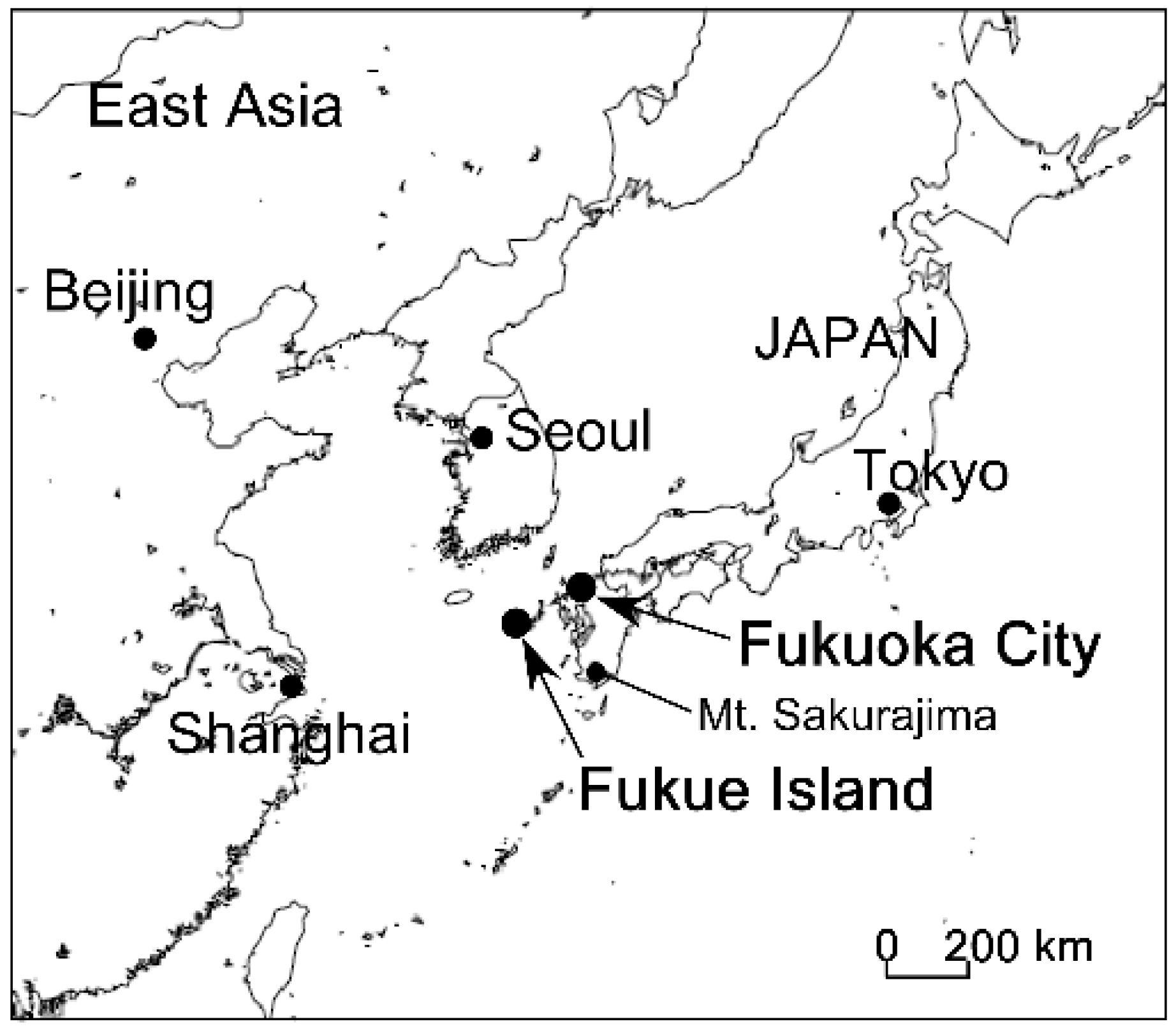



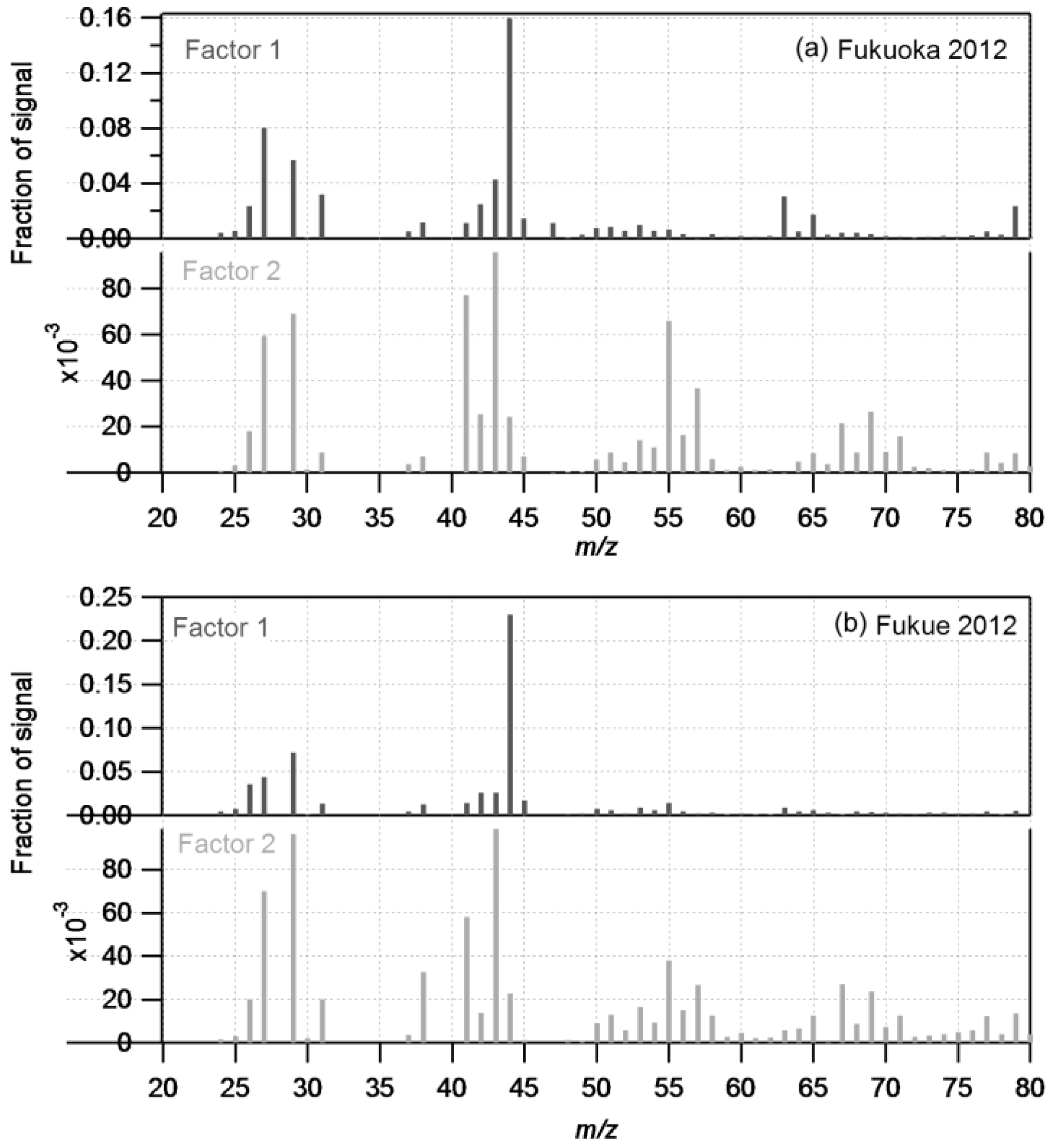


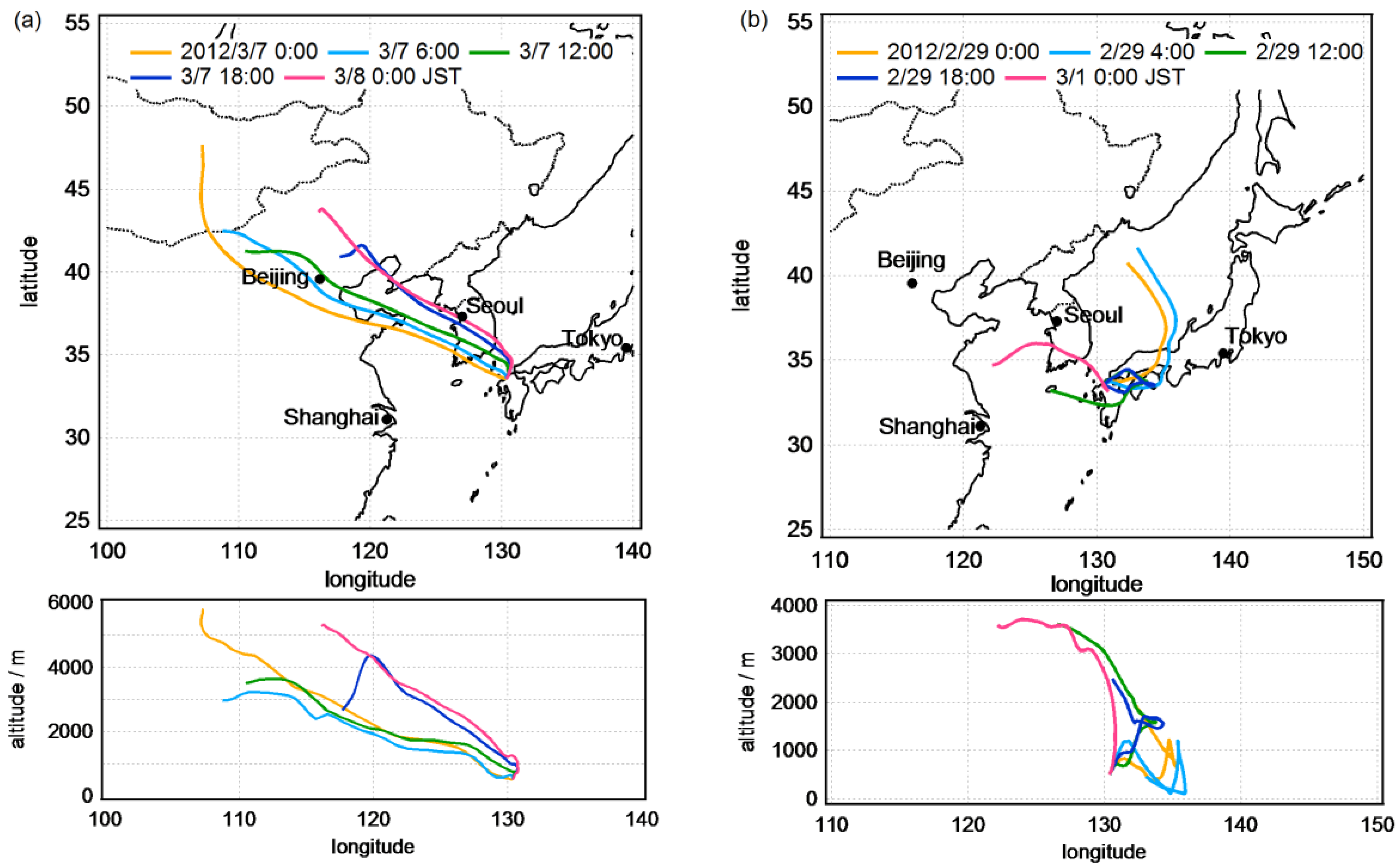


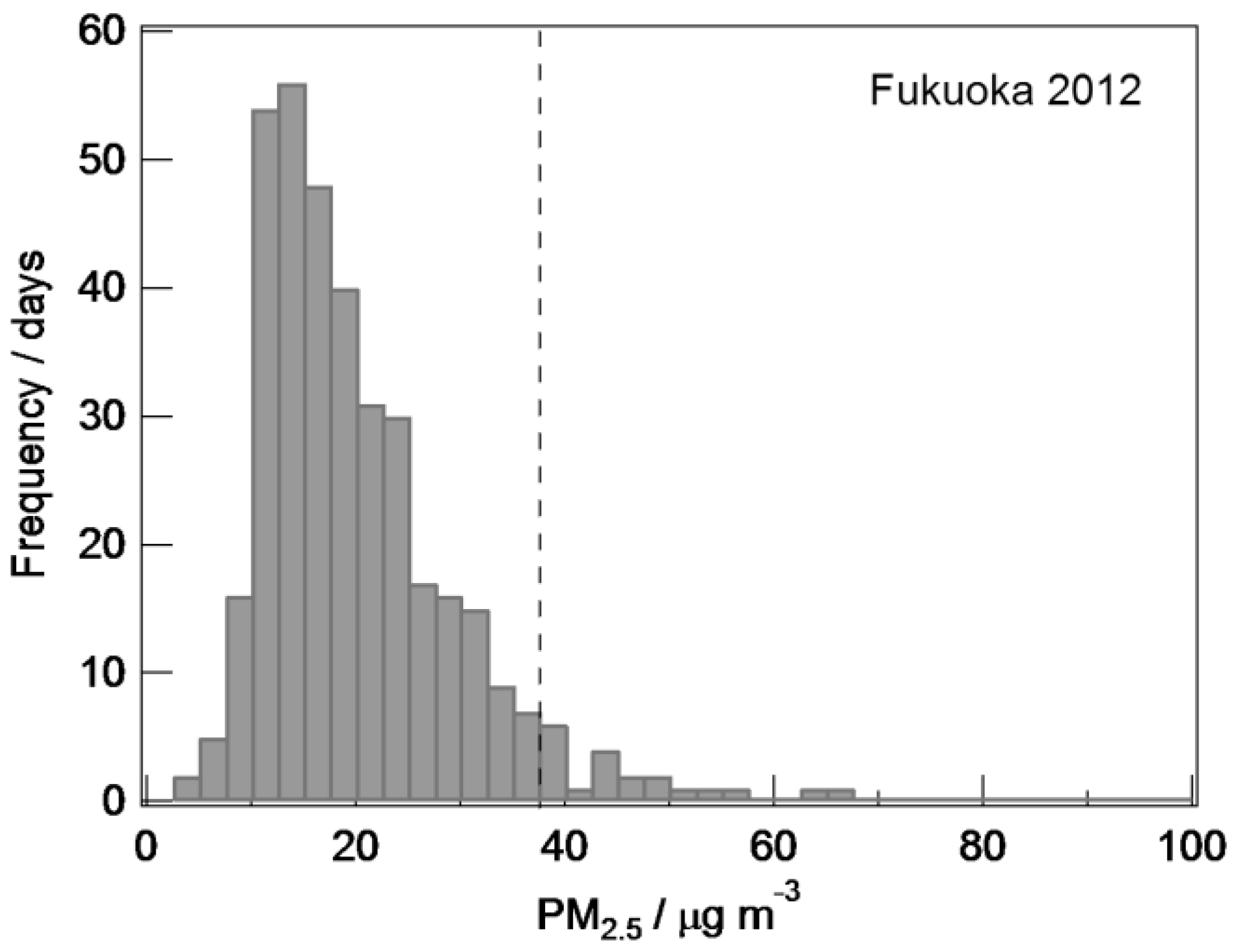
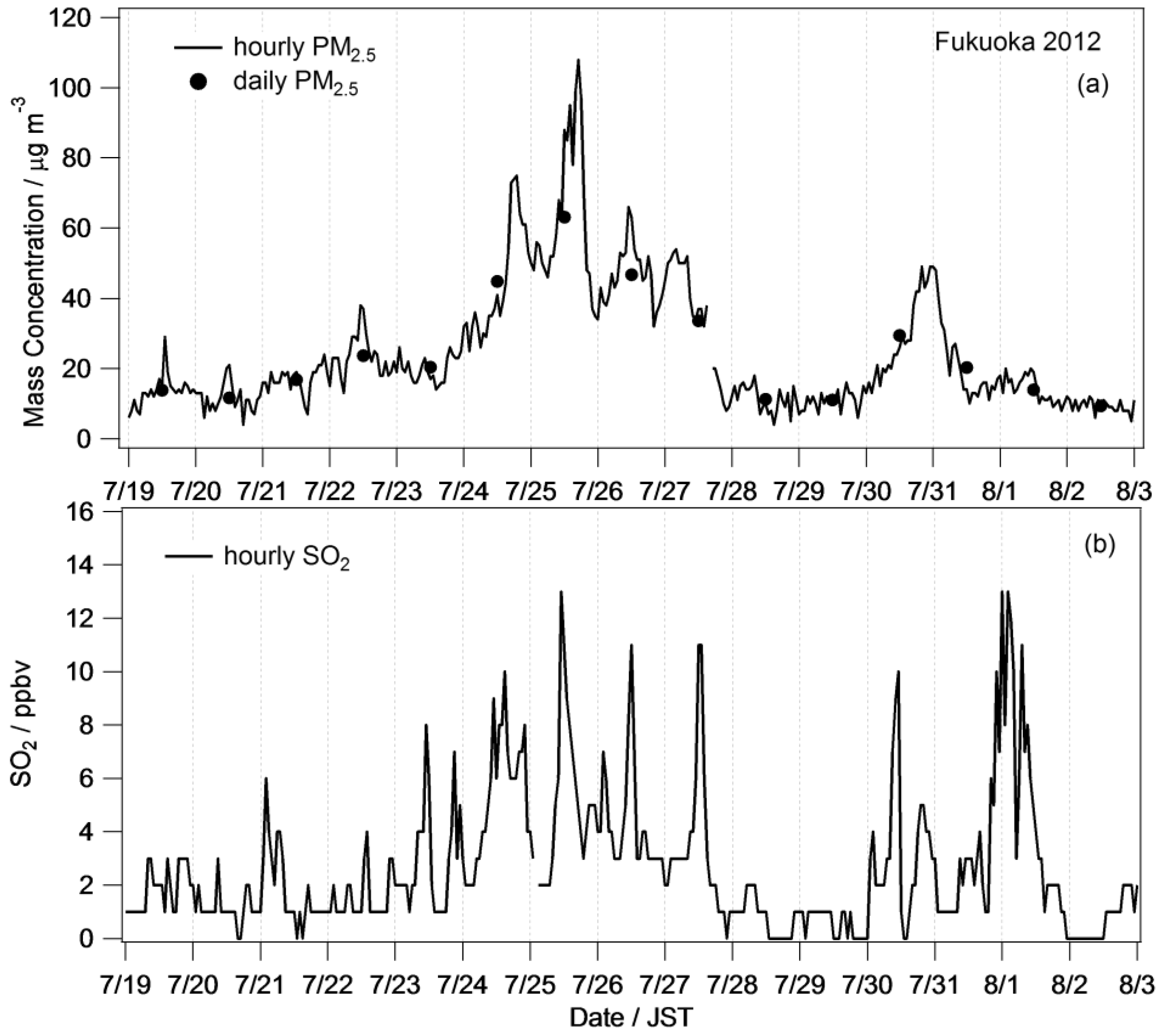

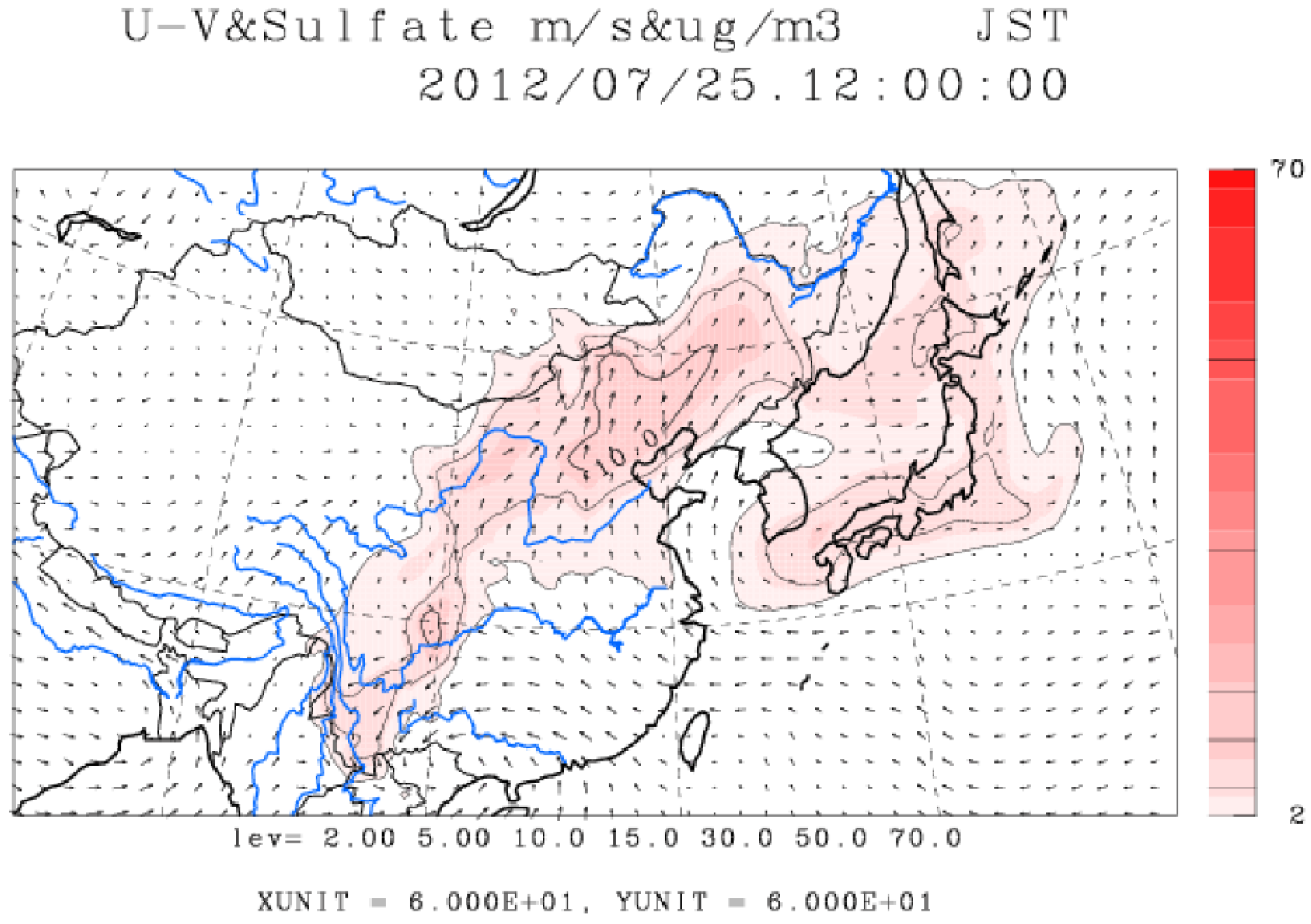
| Fukuoka City/µg·m−3 | ||||||
|---|---|---|---|---|---|---|
| Month | PM2.5 | Ammonium | Nitrate | Sulfate | Chloride | Organics |
| January | 16 | 1.3 | 1.0 | 2.5 | 0.1 | 2.7 |
| February | 13 | 3.1 | 2.5 | 4.9 | 0.3 | 6.4 |
| March | 19 | 2.7 | 1.7 | 4.4 | 0.1 | 4.6 |
| April | 20 | 2.1 | 0.8 | 3.8 | 0.1 | 3.7 |
| May | 26 | - | - | - | - | - |
| June | 18 | 2.1 | 0.8 | 4.5 | 0.1 | 6.2 |
| July | 23 | 2.6 | 0.4 | 7.2 | 0.0 | 4.8 |
| August | 15 | 0.8 | 0.2 | 2.2 | 0.0 | 3.3 |
| September | 16 | 1.1 | 0.2 | 2.5 | 0.0 | 2.3 |
| October | 15 | 0.9 | 0.4 | 1.6 | 0.0 | 2.7 |
| November | 16 | 1.5 | 1.0 | 2.7 | 0.1 | 3.4 |
| December | 11 | 1.4 | 0.9 | 2.6 | 0.1 | 2.7 |
| Fukue Island/µg·m−3 | ||||||
| Month | PM2.5 | Ammonium | Nitrate | Sulfate | Chloride | Organics |
| January | 16 | 1.2 | 0.4 | 4.6 | 0.0 | 3.3 |
| February | 13 | 0.9 | 0.3 | 3.6 | 0.0 | 2.5 |
| March | 20 | 2.7 | 0.7 | 5.6 | 0.1 | 4.2 |
| April | 14 | 1.3 | 0.4 | 4.0 | 0.1 | 3.4 |
| May | 20 | 1.3 | 0.2 | 4.1 | 0.0 | 3.5 |
| June | 14 | - | - | - | - | - |
| July | - | - | - | - | - | - |
| August | - | - | - | - | - | - |
| September | - | - | - | - | - | - |
| October | 14 | 0.5 | 0.1 | 1.9 | 0.0 | 1.6 |
| November | 15 | 0.6 | 0.1 | 2.2 | 0.0 | 1.7 |
| December | 11 | 0.6 | 0.1 | 3.5 | 0.0 | 2.0 |
© 2016 by the authors; licensee MDPI, Basel, Switzerland. This article is an open access article distributed under the terms and conditions of the Creative Commons by Attribution (CC-BY) license (http://creativecommons.org/licenses/by/4.0/).
Share and Cite
Yoshino, A.; Takami, A.; Sato, K.; Shimizu, A.; Kaneyasu, N.; Hatakeyama, S.; Hara, K.; Hayashi, M. Influence of Trans-Boundary Air Pollution on the Urban Atmosphere in Fukuoka, Japan. Atmosphere 2016, 7, 51. https://doi.org/10.3390/atmos7040051
Yoshino A, Takami A, Sato K, Shimizu A, Kaneyasu N, Hatakeyama S, Hara K, Hayashi M. Influence of Trans-Boundary Air Pollution on the Urban Atmosphere in Fukuoka, Japan. Atmosphere. 2016; 7(4):51. https://doi.org/10.3390/atmos7040051
Chicago/Turabian StyleYoshino, Ayako, Akinori Takami, Kei Sato, Atsushi Shimizu, Naoki Kaneyasu, Shiro Hatakeyama, Keiichiro Hara, and Masahiko Hayashi. 2016. "Influence of Trans-Boundary Air Pollution on the Urban Atmosphere in Fukuoka, Japan" Atmosphere 7, no. 4: 51. https://doi.org/10.3390/atmos7040051
APA StyleYoshino, A., Takami, A., Sato, K., Shimizu, A., Kaneyasu, N., Hatakeyama, S., Hara, K., & Hayashi, M. (2016). Influence of Trans-Boundary Air Pollution on the Urban Atmosphere in Fukuoka, Japan. Atmosphere, 7(4), 51. https://doi.org/10.3390/atmos7040051







